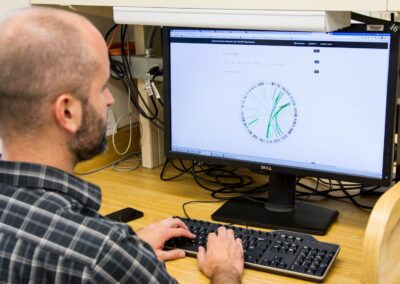Understanding the Potential Risks and Strategies for Minimization
The Promise and Perils of CRISPR Technology
The potential risks of off-target effects in CRISPR-based genetic modifications remain a significant concern. These off-target effects, where CRISPR inadvertently edits DNA sequences other than the intended target, can lead to unintended mutations and complications.
In regions such as Saudi Arabia and the UAE, where advancements in biotechnology are rapidly embraced, understanding and mitigating these risks is crucial. Researchers and policymakers in Riyadh and Dubai are particularly interested in ensuring that the benefits of CRISPR are realized while minimizing any potential negative impacts. This balance is vital for maintaining public trust and fostering innovation in genetic engineering.
The precision of CRISPR technology relies on its ability to accurately target specific DNA sequences. However, even small inaccuracies can result in off-target effects. These unintended edits can disrupt genes, leading to unexpected phenotypes and potentially harmful consequences. Therefore, developing robust strategies to minimize off-target effects is essential for the safe and effective use of CRISPR.
Technological Advancements to Reduce Off-Target Effects
Technological advancements are continually being developed to enhance the accuracy and specificity of CRISPR. One such approach is the improvement of CRISPR-Cas9 enzyme variants. Researchers have engineered high-fidelity Cas9 variants that exhibit reduced off-target activity. These variants maintain the editing efficiency of the original Cas9 while significantly decreasing the likelihood of unintended edits.
Another promising strategy involves the use of alternative CRISPR systems. For instance, CRISPR-Cpf1 (also known as Cas12a) is a newer enzyme that offers distinct advantages over Cas9, including a different mechanism of DNA recognition and cutting. Studies have shown that Cpf1 can reduce off-target effects compared to Cas9, making it a valuable tool for precise genetic modifications.
Artificial intelligence (AI) and machine learning are also playing a pivotal role in minimizing off-target effects. AI algorithms can predict potential off-target sites by analyzing genomic sequences and identifying regions with high similarity to the target sequence. By integrating AI with CRISPR technology, researchers can design guide RNAs that are less likely to bind to off-target sites, enhancing the specificity and safety of genetic modifications.
Practical Approaches in Research and Clinical Applications
In practical applications, several approaches are being employed to reduce off-target effects in CRISPR-based genetic modifications. One such approach is the use of shorter guide RNAs. Shorter guide RNAs are less likely to bind to non-target sites, thereby reducing off-target activity. This method has shown promising results in various studies, making it a viable option for precise genetic editing.
Another effective strategy is the use of dual-guide RNAs. By designing two guide RNAs that target adjacent regions of the DNA sequence, researchers can increase the specificity of the CRISPR system. This dual-targeting approach requires both guide RNAs to bind accurately for the Cas9 enzyme to make a cut, thereby reducing the likelihood of off-target effects.
In clinical settings, rigorous screening and validation processes are essential to ensure the safety and efficacy of CRISPR-based therapies. Comprehensive genomic analysis techniques, such as whole-genome sequencing, can identify potential off-target effects and unintended mutations. By thoroughly screening edited cells before clinical application, researchers can mitigate risks and ensure the reliability of genetic modifications.
Global Perspectives and Regional Contributions
CRISPR Research in Saudi Arabia and the UAE
Saudi Arabia and the UAE are at the forefront of CRISPR research and innovation. Institutions in Riyadh and Dubai are investing heavily in biotechnology, recognizing the potential of CRISPR to address critical challenges in medicine, agriculture, and environmental conservation. Collaborative efforts between researchers in these regions and global experts are driving advancements in CRISPR technology.
In Riyadh, research centers are focusing on harnessing CRISPR for medical applications, such as developing therapies for genetic disorders. By leveraging the latest advancements in AI and machine learning, these centers are improving the precision and safety of CRISPR-based treatments. The commitment to ethical research and rigorous safety standards ensures that the benefits of CRISPR are realized while minimizing potential risks.
Dubai is also emerging as a hub for CRISPR research, with initiatives aimed at enhancing agricultural productivity and sustainability. Researchers are exploring the use of CRISPR to develop crops that are resistant to pests and environmental stresses. By reducing reliance on chemical pesticides and enhancing crop resilience, CRISPR technology is contributing to sustainable agriculture in the region.
Ethical Considerations and Regulatory Frameworks
The ethical implications of CRISPR-based genetic modifications cannot be overlooked. Ensuring that genetic editing is conducted responsibly and ethically is paramount. In Saudi Arabia and the UAE, regulatory frameworks are being established to govern the use of CRISPR technology. These frameworks aim to balance innovation with ethical considerations, ensuring that genetic modifications are conducted safely and for the greater good.
Public engagement and education are also critical components of ethical CRISPR research. By involving the public in discussions about the benefits and risks of genetic editing, researchers and policymakers can build trust and foster a supportive environment for innovation. Transparency in research practices and clear communication about the potential impacts of CRISPR are essential for maintaining public confidence.
International collaborations are further strengthening the ethical and regulatory landscape of CRISPR research. By working together, countries can establish consistent standards and guidelines for genetic editing. These collaborations ensure that CRISPR technology is used responsibly and that the global community benefits from its advancements.
Future Directions and Innovations
The future of CRISPR-based genetic modifications is promising, with ongoing innovations aimed at improving precision and minimizing off-target effects. Emerging technologies, such as base editing and prime editing, offer new avenues for precise genetic modifications without introducing double-strand breaks. These technologies hold the potential to further enhance the safety and efficacy of genetic editing.
In Saudi Arabia and the UAE, continued investment in research and development will drive the next wave of CRISPR innovations. By fostering a collaborative and innovative research environment, these regions can lead the way in developing safe and effective genetic editing technologies. The integration of AI, machine learning, and advanced genomic analysis will play a crucial role in achieving these goals.
As CRISPR technology continues to evolve, the commitment to ethical research, rigorous safety standards, and public engagement will ensure that its benefits are realized while minimizing potential risks. By addressing the challenges of off-target effects and leveraging the latest advancements in biotechnology, the future of CRISPR-based genetic modifications looks bright and full of potential.
#CRISPR #GeneticModification #OffTargetEffects #Biotechnology #GeneticEngineering #SaudiArabia #UAE #Riyadh #Dubai #ArtificialIntelligence #Blockchain #TheMetaverse #ExecutiveCoaching #GenerativeAI #ModernTechnology #BusinessSuccess #LeadershipSkills #ProjectManagement























